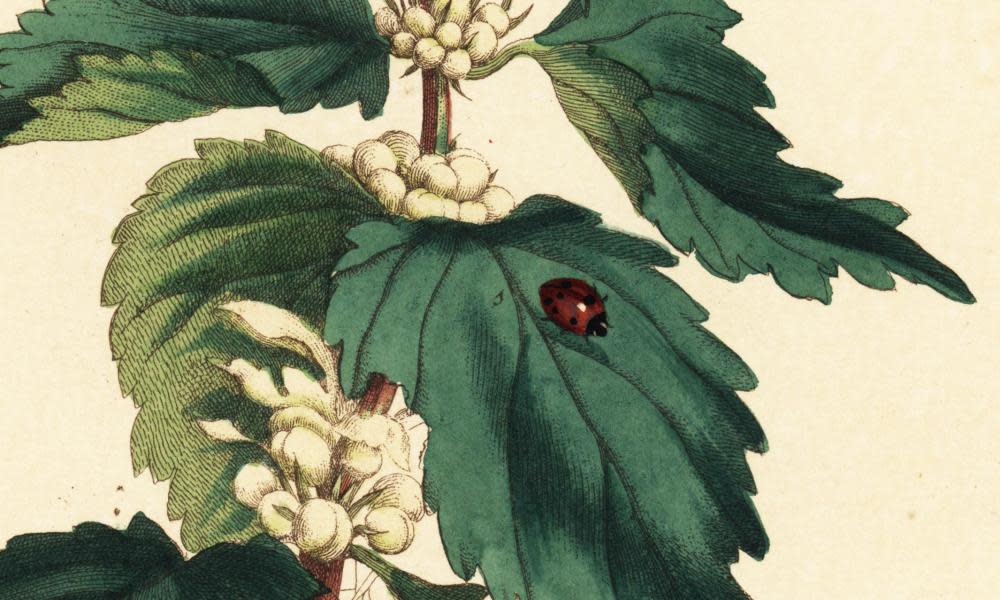A ladybird: how is it possible to love something so small so much?

The ladybird gets the first part of its name from Our Lady, The Lady, Mary. Its spots – seven, if you are in Europe – symbolise Mary’s seven sorrows, its red shell the cloak she wears sometimes, when she is feeling passionate or loving, or devoted to her son, or, when she’s in a particularly generous mood, devoted to all of humanity.
Ladybirds come from the coccinellid family of beetles, which comes from the Latin for scarlet. They were named by Pierre André Latreille, a priest who had grown up an orphan and was thrown into a dungeon during the French Revolution. He was released because he recognised a rare species of beetle. A physician had come to inspect the prisoners, and found Latreille preoccupied by an insect. The story is about to sound like a bible passage written by AI. The insect was very rare, Latreille told the physician. It was a “red-necked bacon beetle”. The physician took the beetle to a local physician, 15 years old, who, impressed, used his connections to get Latreille released from prison. Within a month, every other inmate was dead from “a notorious killing frenzy”. (As they say: God loves beetles.)
Related: A sheep: the mascot of changing seasons | Helen Sullivan
In English, ladybirds used to be ladycows; in French, Polish and Irish they are still sometimes called variations on “little cows of God”; in Welsh, “short red cows”. In Romanian, best of all, they are ladyhens. The bird bit is harder to pin down. It may be because ladybirds fly.
And O, how they fly: it never gets old, to see a ladybird bumbling along, then watch as it opens its forewings (elytra), which are finer than you can ever remember, can ever manage to hold in your head. They shine; they would seem to be made of porcelain if porcelain could be that fine, could be curved and come to a point; and tiny, like a baby’s fingernail. The shell looks like it is made of material that must be incredibly strong to be so thin, that it must be too thin to crack, bend or dent: an impossible substance. And beneath the shell, the soft brown wing.
The ladybird does seem god-like, a kind of umbrella looking down over lesser insects, her prey, laying her eggs on aphids so that when her babies hatch they can eat those instead of the unhatched larvae (ladybird larvae look a bit like soldiers dressed in black rubber armour).
Related: Conservation efforts celebrated as 26 Australian species no longer need threatened listing
Then again, Ladybirds are not chaste. They are sexually and romantically liberated: they know how good they look, and they don’t keep it to themselves. They mate like cows, one awkwardly mounting the other, and I like to think this is how we got vache à Dieu.
How can we love something so small so much? “What, lamb! What, ladybird!” calls Juliet’s nurse, and tells a story about Juliet as a baby; and really she is telling us that she loves Juliet, that she helped to raise her. Juliet, learning to walk, fell forward and hit her head.
She could have run and waddled all about;
For even the day before, she broke her brow,
And then my husband – God be with his soul!,
A’ was a merry man – took up the child.
‘Yea,’ quoth he, ‘dost thou fall upon thy face?
Thou wilt fall backward when thou hast more wit,
Wilt thou not, Jule?’ and, by my holidam,
The pretty wretch left crying and said ‘Ay’.
To see now how a jest shall come about.
I warrant, an I should live a thousand years,
I never should forget it. ‘Wilt thou not, Jule?’ quoth he,
And, pretty fool, it stinted and said ‘Ay’.
And if, when Nurse called Juliet ladybird, your whole heart had not already turned as red and shining as nail polish and got up on six tiny legs and started crawling around in our chest, filled with love, it does then.
Helen Sullivan is a Guardian journalist. Her first book, a memoir called Freak of Nature, will be published in 2024
Have an animal, insect or other subject you feel is worthy of appearing in this very serious column? Let me know: helen.sullivan@theguardian.com

 Yahoo News
Yahoo News 
